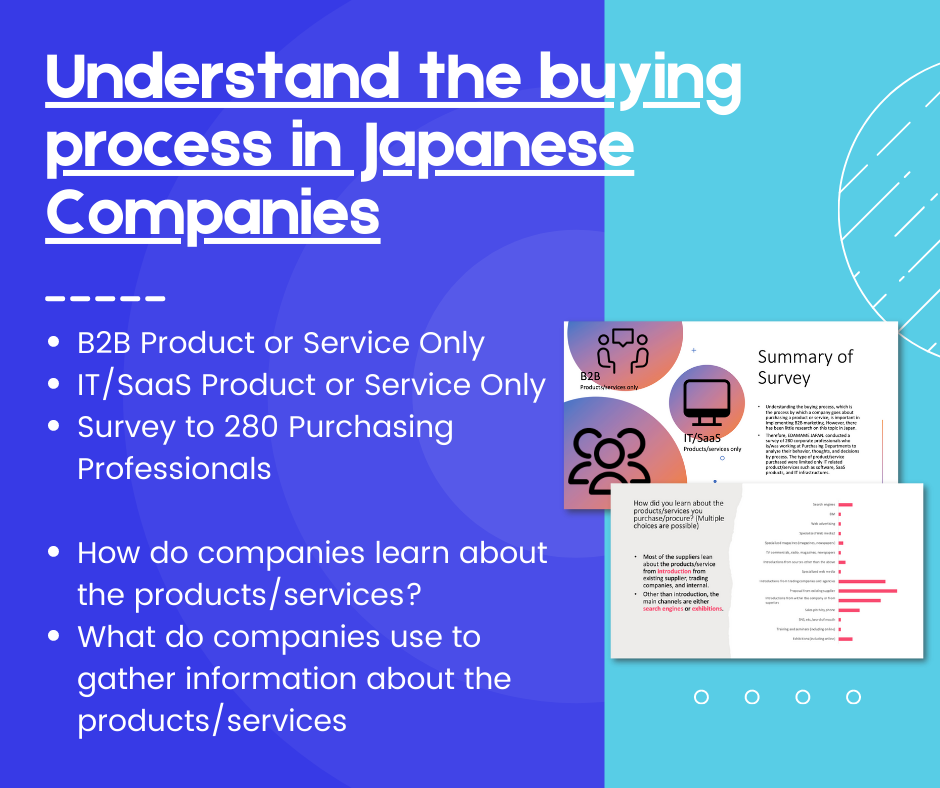Marketing in Japan | Understanding the Japanese market and customers

Imagine trying to sell a product in a market where the slightest scratch on an item can lead to complaints, where food must always be at the peak of freshness, and where trends change as quickly as the wind. Welcome to the world of marketing in Japan, a landscape as challenging as it is rewarding.
In this land, a rumor about bananas aiding weight loss can empty supermarket shelves in a flash, and a new shop opening in Ginza can generate queues that last for hours.
Intrigued? You should be.
In this article, we’re going to delve into the fascinating world of Japanese consumer behavior and reveal the secrets of successful marketing in Japan. So, buckle up and get ready for an enlightening journey!
Introduction
Navigating the intricate landscape of marketing in Japan can be a complex endeavor for non-Japanese companies. The Japanese market, known for its unique characteristics and high standards, presents a myriad of opportunities for businesses willing to understand and adapt to its nuances.
Brief Overview of the Japanese Market
Japan, the third-largest economy in the world, boasts a consumer market that is both sophisticated and diverse. With its high internet penetration rate and tech-savvy consumers, digital marketing in Japan offers a fertile ground for businesses to thrive. However, marketing in Japan is not without its challenges. Japanese consumers are known for their strict product selection standards, attention to detail, and a strong preference for quality and safety. This makes the Japanese market distinct from many others, requiring a tailored approach to marketing strategies.
Importance of Understanding Japanese Consumer Behavior
Understanding Japanese consumer behavior is crucial for successful marketing in Japan. Japanese consumers are not only discerning in their choices but also highly influenced by trends, brand reputation, and word-of-mouth recommendations. They value safety, quality, and the freshness of products, and they have a strong affinity for brands that can consistently deliver on these aspects.
Moreover, cultural nuances play a significant role in shaping consumer behavior in Japan. From the respect for tradition and local customs to the importance of social harmony, these cultural factors often reflect in the purchasing decisions of Japanese consumers. Therefore, businesses aiming to succeed in marketing in Japan need to grasp these cultural and behavioral aspects to craft marketing strategies that resonate with the Japanese audience.
In the following sections, we will delve deeper into the intricacies of the Japanese market, consumer characteristics, and effective strategies for marketing in Japan. Whether you are a seasoned marketer or a business looking to venture into the Japanese market, this guide will provide you with valuable insights to navigate your marketing journey in Japan.
Background of marketing in Japan
Although the Japanese customer said to be the hardest customer in the world, it is also said that the digital marketing activities are not “mature” as other developed counties according to Boston Consulting Groups Reports. And here are why.
History of marketing in Japan
After the war in Japan, when the Japanese population was growing and demand was rising, marketing was not so important, and if things were made in good quality, they were sold anyway. In a situation where there were few media options and the amount of information available to consumers was limited, mass advertising could sell high-quality Japanese products backed by high technology.
Even today, Japanese companies still have a product orientation that says, “If you make something good, you can sell it.” When talking to executive officers, including the CEO, and the heads of the marketing department, it is felt that companies with strong products and services have a weaker marketing orientation and marketing functions. Many companies have a marketing department built into their sales department.
Changes in marketing in Japan
However, in the future, the idea of marketing-driven will be needed more than ever.
First, a big change is taking place on the consumer side. Consumer and purchasing needs, which had tended to be homogeneous, have been fragmented. No effect can be expected even if the demographic attributes, such as gender, age, and region, are used anymore, and purchases will not be made unless detailed and careful responses are taken according to diversified individual needs and consumption values. There is a tendency for more customized and personalized products.
It is the evolution of the media platform that enables consumers to respond to changes and encourages purchases. In addition to the four mass media of TV, newspapers, magazines, and radio, digital media and social platforms are emerging. There is a huge amount of content being generated in real-time, creating an environment where you can search for the information you want to know whenever and wherever you want, regardless of location.
5 Japanese consumer characteristics for marketing in Japan
Considering the marketing is evolving in Japan, and facing one of the most unique consumers in the world, here are the main Japanese consumer characteristics that help your marketing in Japan.
Safety and security
You would hear pretty much all Japanese company claim their products or service are safe and secure (“安心・安全”). The reason is that that’s what Japanese customers care about.
Safety is the most and fundamental aspects of the Japanese consumer’s behavior. They will not risk their life or money, without that the products or services would not be in option at all. This concept is actually tied to the following aspects of consumer behavior as well.
Quality and details
Japanese customers sometimes complain about even a slight wound on a product. GMS in Europe and the United States had a hard time entering Japan.
For example as a famous story, when Walmart entered Japan. There was a photo stand in the store, but it was cheap and the design was not so bad. However, the backside was stopped with a stapler, and the needle came out as it was. It’s common sense to put a sticker on top of a Japanese product to hide it, but non-Japanese say that you can’t see the back. But Japanese consumers care about such details, and that Walmart’s private brand didn’t sell at all.
Fresh and trendy
Japanese customers like new things. That’s the case for freshness in food, and if you have a new product or shop, you may be interested in it.
They like new things and jump right away, but if there is another store, it will jump again. Also, newness is not limited to products, but also to stores. Good products are a matter of course, and the Japanese market is always in demand for novelty.
Brand orientation
Japanese are very brand-oriented. Louis Vuitton and Gucci are good examples. Looking at Moet Hennessy-Louis Vuitton Group (LVMH) ‘s fashion sales by country, Japan accounted for 26% in 2006 and 22% in 2006.
Recently, China has been rapidly growing as such a brand market, and in Japan, it has been said that some people are trying to move away from “mass luxury” which can be seen at a glance. But in general, you can say that brand orientation is strong.
Review and word of mouth
The majority of Japanese consumers base their social and third-party evaluations on purchasing decisions, such as reputation and word of mouth
According to the American Express Report, as a decisive criterion when deciding on a new purchase, many people in Japan, India, and Mexico value corporate reputation the most, and in the other six markets, recommend friends and family (US, UK, Singapore), “Sale and sales promotion activities (promotion)” (Canada, Italy, Hong Kong).
In the Japanese market, online social media word-of-mouth is second (20%), combined with a first-place corporate reputation (35%), making it 55%, with a majority of people saying “reputation”. It turns out that social and third-party evaluations, such as word-of-mouth, are used as criteria in purchasing decisions.
2 aspects you should be careful when marketing in Japan
Also below describe two general aspects you should be paying attention to when you are marketing in Japan.
Respecting culture
Many non-Japanese may recognize that Japan is a non-religious country, but it is not. There are definitely Japanese traditional values that are not actually found in foreign countries.
There is no doubt that it is one of the important factors to consider when developing marketing in the Japanese market. Ignoring this in the Japanese market is as much as ignoring halal (food and dishes allowed under Islamic law) to market food in the Islamic market. is there.
Government regulations
It is important to mention the market characteristics of the developed countries, which are still strongly regulated by the central government, which often constitutes a marketing hurdle. It is worth noting that even the unicorn companies that have disrupted the sharing economy around the world, like UBER, have not been able to expand their business in the Japanese market as they wished.
In Japan, no matter how convenient, inexpensive and innovative services are provided, if they drastically disrupt traditional industry models or violate traditional values of national life, It has a high chance to be subject to government regulation at any time. Marketers who always pursue new things must be willing to make decisions while keeping that risk in mind.
The difference between Japanese and non-Japanese (overseas) marketing techniques in Japan
Did you know that there is a difference in marketing techniques between Japan and other countries? If you are doing business with the same marketing that is considered good in other countries, you may be confused or surprised to learn how it differs from Japanese marketing. In this article, I’d like to talk about the differences between Japanese and foreign marketing methods.
Aimed at the domestic market than wide range of overseas markets
One of the differences between Japanese marketing and overseas marketing seems to be the difference in whether the product tends to be aimed at the domestic market or whether it is something that can be sold overseas as well. In Japan, until recently, many products have been made for the domestic market, such as mobile phones that are unique to the country and brand-oriented consumer electronics products, such as Japanese unique mobile phone culture, so-called “Galakei”.
On the other hand, overseas products, even if they are imitations or low-price products, tend to offer products that can be sold in accordance with the overseas market so that they can increase their market share significantly. This tendency is one of the reasons why Japan has been able to outperform its rivals in marketing in the world.
limited commercial and supply chain flow
Another difference between Japanese marketing and overseas marketing is whether or not you are limiting your business flow. In Japan, products are basically free to be sold at any retailer with no restrictions on sales, but overseas, the company’s products may be restricted to be sold by certain retailers.
This is a strategy to protect the brand image of the company in order to avoid the possibility that the company’s image might be damaged by being sold products without permission. As you can see, there are differences in marketing between Japan and other countries in terms of whether or not to place restrictions on dealers in order to protect the trust of the company’s brand.
Difference between understanding customers’ claims or feedback
Another difference between Japan and other countries is the difference in claims. Japanese consumers don’t make direct complaints and if they don’t like something, they don’t come to the store.
This difference is having an impact on overseas marketing, and there are stories of overseas tourists struggling with this trend, especially among Japanese consumers. The difference in marketing between Japan and other countries is evident in the fact that there are many differences in perceptions of how to deal with hidden crema in Japan and abroad.
The above is the difference between Japanese and foreign marketing methods. By knowing the differences, you may be able to use them in your marketing.
Conclusion
Understanding Japanese customers and marketing in Japan are indeed not easy, however, not impossible. I’ve seen many non-Japanese companies had successful Japanese marketing activities and grew.
Above are very fundamentals but also since its very essential parts of Japanese markets, you could succeed by taking accounts of those.
For more detail and industry-specific market research, EDAMAME Japan’s Market Research can help you.
About us and this blog
We are a digital marketing company with a focus on helping our customers achieve great results across several key areas.











